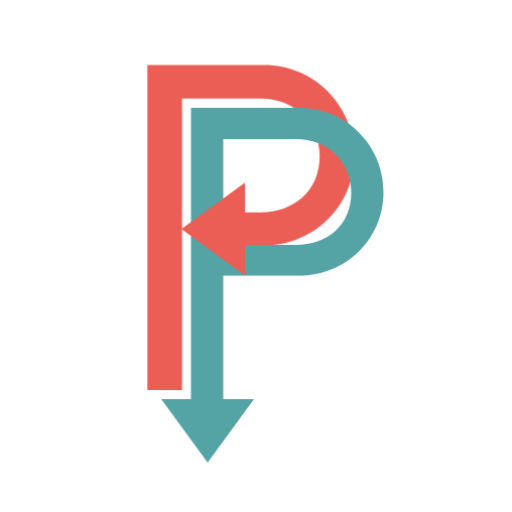Scrum may initially sound complicated until you get the hang of it. So I was glad to see it’s one of the most straightforward and practical I have ever tried. I love how, through Scrum, I can split a large and complex project into simpler and more manageable tasks.
We, project management experts, call these sprints. And by the end of each cycle, teams must present their progress to stakeholders and receive feedback.
Today, I’ll detail everything there is to know about the Scrum approach. Hence, you’ll benefit greatly since this framework could transform your team into successful specialists.
You migth also be interested in: Complete Guide to Scrumban Project Management: All You Need to Know About This Framework
Key Takeaways
- Scrum is an agile project management framework that focuses on incremental progress, communication, and collaboration;
- It consists of five stages – initiation, planning, execution, review, and release;
- Scrum is ideal for software development, smaller teams, and projects that face a lot of uncertainty.
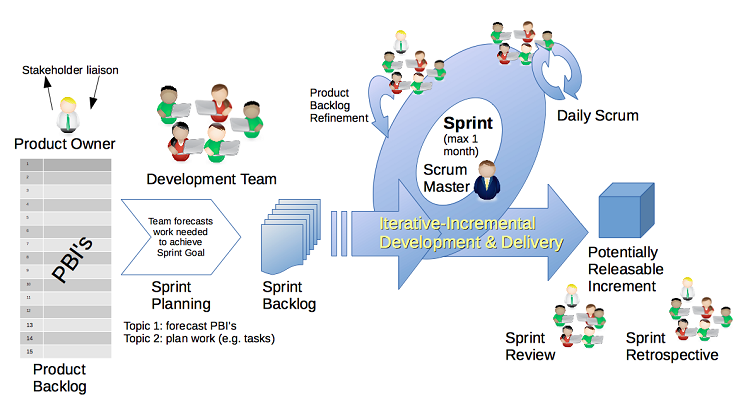
Complete Guide to Scrum Project Management
Below, I’ll detail what Scrum is, its best practices, pros, cons, and stages. I’ll talk based on my experience and research.
What It Is
Opt for the Scrum methodology if you want increased agility in your project management initiatives. It’s a practical framework highlighting accountability, teamwork, and incremental progress. All these aim to help you achieve your final and, hopefully, well-defined product goal.
It comes with plenty of structure. As long as you follow Scrum’s guidelines and best practices, your project should succeed, and your deliverables should be completed on time.
Scrum Principles – Best Practices
Scrum relies on the Agile Manifesto that promotes the following ideas. These that I’m about to detail are part of the underlying mindset that led to all Agile frameworks.
Interaction and People Over Tools and Processes
Scrum focuses mainly on team members and their relationships rather than tools or processes. Therefore, communication is Scrum’s most crucial element. Thus, this project type promotes cross-functional teams and self-organizing individuals.
Choosing Customer Collaborations
The Scrum approach puts collaborations above contract negotiations. Throughout the project, teams keep clients updated and communicate with them at every single phase. Client involvement is regular and consistent in Scrum projects.
Working Products and Quick Delivery
Instead of focusing their resources on comprehensive documentation, Scrum masters want to achieve working software that can be quickly delivered to clients. It’s time-saving. So, Scrum bases all its operations on spring cycles. Having quick and effective workflows are there for a reason. Each sprint offers a product increment.
Encouraging Change Instead of Rigid Plans
Scrum teams embrace change and make uncertainties work in their favor. Increasing responsiveness to change and making the proper adjustments are what Agile methodologies stand for. Moreover, Scrum has important values that help employees remain courageous and proactive when unexpected things occur.
You could be a great Scrum team member if you’re open, courageous, committed, respectful, and focused. These further lead to boosted trust and transparency.
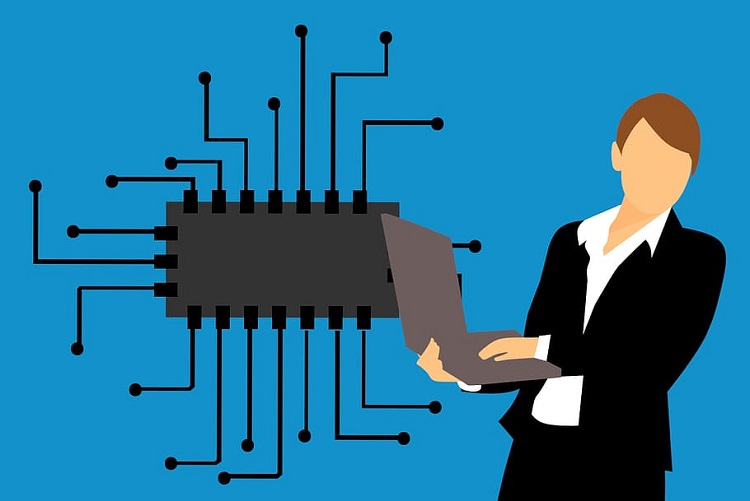
Scrum Elements
Scrum has four important components:
- Product backlogs – lists that contain work items employees must complete. It’s also seen as a checklist that team members change or update constantly;
- Sprint backlogs – product backlogs are grouped into sprint backlogs. Each sprint contains its backlog with multiple product lists;
- Product backlog items – what you must do to obtain what the client wants;
- Increments – usable end products created after the sprints.
These are called artifacts that Scrum works with.
Product Backlogs
One of these lists contains a product’s functions, characteristics, and requirements. Teams place these features in a specific order based on their importance. Backlogs will include modifications that keep up with the market or the client’s renewed demands.
Sprint Backlogs
Several backlog items create a spring backlog, all those chosen to be processed during a sprint. It’s also about the plan that teams put together that helps them show a working product when each sprint is over.
Product Backlogs Items
Each product backlog contains multiple items. An item describes what employees must do in terms of changes. It also shows the project’s desired outcome. You must express these elements through user stories and simple sentences explaining the user’s demands.
Example: As a blog owner, I want to publish high-quality, unique, and relevant content so that I can attract more followers and increase my email database.
Increments
After each sprint, there are different versions of the same product. They’re called increments. After the final sprint, the team must provide clients with the best option for their product.
So, you’re developing a product’s beta version but improving it with every sprint. That’s why Scrum requires employees to create, integrate, test, and deliver results.
Scrum Stages

Scrum has five phases that I’ve detailed below.
Initiation
During initiation, I usually contribute to my project’s vision. I establish the stakeholders with my colleagues, choose a Scrum Master, and create the process’s backlog. This first stage must be solid since it represents the project’s foundation.
Besides the elements I’ve mentioned above, one should also outline their roadmap, consisting of goals and deliverables. For those of you who’re wondering what backlogs are, they’re listed features that teams will implement throughout the project.
In the end, they will lead to the final product. Moreover, my team orders these characteristics based on their priority.
Planning
The second Scrum stage is planning, when estimates take place. During planning, employees must develop feasible plans for all Scrum sprints. A sprint is a time-defined and short period that leads to improvement. It’s a great way to boost productivity. The project backlog comprises several sprints. Moreover, they rely on user stories.
Different user stories create one project epic. Let me give you an example:
Product Epic – As a blog owner and content creator, I want my website to rank on the first page of Google Search.
- First user story – I want and need to publish ten articles that are valuable for my readers and relevant to my niche;
- Second user story – I want each article page to have a pop-up subscription form where my readers can start following my content;
- Third user story – I want to develop a strong communication strategy, sending the same kind of message on all channels, including through newsletters and social media. These should also have click baits that online users can press to access my articles.
As you can see from the above example, Scrum follows an iterative development framework. Each sprint should last up to two to four weeks. Teams should also estimate the results they can achieve after completing every sprint. That’s an effective way to compare one’s expectations to actual results.
Implementation
Also known as execution, the implementation phase is when teams start working on the product. All staff members must update the project backlog while removing already finished elements. Daily meetings are in order if you want to review the plan and strategy or discuss any potential concerns.
Both implementation and planning stages can be repeated several times before the project’s due date. Around this time, you should take care of deliverables and execute tasks.
Implementation’s daily meetings must be kept short to check if the team’s progress aligns with the project’s objectives. It’s the right time to talk about what has been done so far, what the following tasks are, and what issues must be solved.
Meetings and burndown charts enable better communication.
Review
If you want to achieve a comprehensive retrospective of all the sprints, you should take advantage of the review stage. This is essential after every single sprint. It’s when all those involved give and receive valuable feedback.
Through this meeting, you can adjust procedures to obtain successful transitions that will further lead you to the second or third estimation and planning phases.
My team’s results were optimal only when brainstorming ideas during the review stage. We even took a project to the next level. We created an even more extensive process by analyzing our process capabilities.
There should be four types of review phases:
- Sprint review;
- Sprint retrospective;
- Grooming the product backlog – removing or adding tasks and notes;
- The final project retrospective – is done when the entire project is completed.
Before releasing the product, you should ask yourself:
- What went well;
- What went poorly;
- Things we could do to improve the process.
Release
Scrum’s final stage is the release phase. It’s about finishing all deliverables and getting them ready to be shipped to the client. Hence, the project should prise itself with a successful completion.
In the end, the Scrum master should gather up the team to review everyone’s work again. This allows for improvements in future projects.

How to Implement Scrum
You must follow five guidelines if you want your Scrum project to be successful.
Define the Project’s Elements
Any Scrum project must have four elements:
- The team – most teams have between four and nine members. My team consists of seven members, all of which work closely together. There’s a variety of specialists inside the working unit. Some are development experts, while others could have design skills, customer support abilities, and more;
- Scrum Master – the person who guides the team is the leader or Scrum master. They ensure a smooth workflow and an efficient process. Masters are also those who fix issues that arise along the way;
- The product owner – this person has client-related responsibilities. Simply put, owners ensure the client’s needs are met by creating user stories and including them in the backlog. They’re the middlemen between clients and team members;
- Sprint length – from my experience, a typical sprint lasts from two weeks to one month, give or take a few days. But, they should be consistent within the same project; if the first sprint finishes in two weeks, the rest of the sprints should have about the same time box.
Group and Prioritize Tasks
Create tasks, include them in the backlog, assign them, and ensure they’re accomplished based on their urgency. Or so should Scrum masters do. Typically, the roadmap contains pending activities, functionality lists, and priorities. Here’s what backlogs contain:
- Epics – these provide rough work ideas, and they’re high-level requirements;
- User stories – smaller parts of epics are stories. They’re more detailed requirements;
- Tasks – even smaller parts of user stories. Each job is well-structured and targets one sub-goal completed in a sprint.
Plan the Project Sprints
This is done during the first meeting, also known as the brainstorming meeting. Team members pick their desired tasks. Then, they establish how much time they need to finish those tasks without exceeding the deadline.
Employees make commitments and estimations regarding their duties. Nobody starts working on the sprint until everyone agrees on these matters.
Conduct Daily Meetings
Brief yet efficient daily meetings are a must for Scrum projects. Due to these get-togethers, you can visualize the project’s progress much better throughout its different stages. Therefore, you’ll be able to solve any challenges or problems that could appear while also identifying potential delays.
I recommend you use automated PM tools to update the backlogs and make notes after every meeting. This tool type also lets you reorder priorities.
I can’t stress this enough: communication is vital if you apply the Scrum approach. So, all of you Scrum Masters should not shy away from bringing up achievements and challenges.
For maximum efficiency, Scrum meetings should last a maximum of 15 minutes. Also, to create a routine that everyone can easily follow, you should schedule these daily gatherings at about the same time. Discuss the following:
- The things that were completed the day before;
- The tasks required for tomorrow;
- Any achievements that teams accomplished;
- Any obstacles employees encountered.
Review Sprints
Reviews are important because if one or a few tasks still need to be finished before a sprint’s deadline, teams might need to go back and complete them.
Otherwise, you could transfer those assignments to the following sprint. Employees should discuss the improvements that could be made and the things that went as planned.
In Scrum projects, all members are encouraged to participate in meetings and propose their improvement suggestions actively.
Scrum Team & Roles
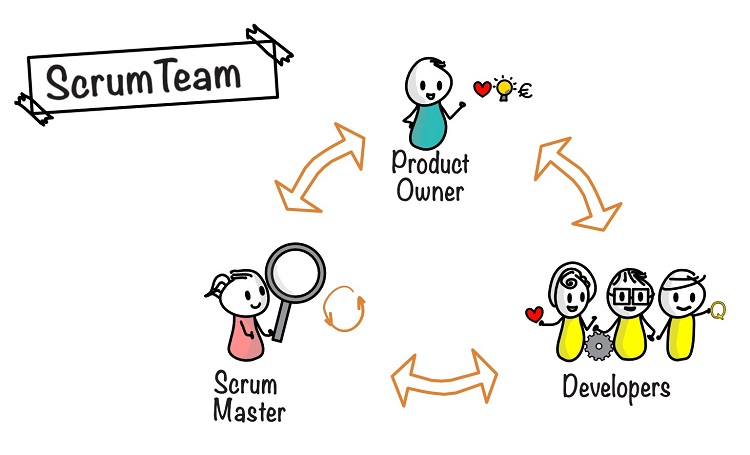
Scrum teams have three components: the developers, product owners, and Scrum masters.
The Development Team
This professional group is meant to create and deliver the final product of a Scrum project. Ideally, team members should present the following traits and abilities:
- Self-organizing skills – they should know and be willing to go from product backlogs to sprint increments on their own;
- Cross-functional abilities – all employees must know how to achieve successful increments. They should want to pitch in;
- High sense of responsibility – everyone should be responsible for both failures and achievements. The entire team is involved, even when one single member makes mistakes.
Scrum teams have the following responsibilities:
- Planning sprints;
- Reviewing sprints;
- Solving problems;
- Meeting sprint goals;
- Managing tasks;
- Prioritizing activities;
- Completing project deliverables.
Scrum Masters
Masters oversee the entire product development process. They facilitate the project and ensure teams understand the requirements and Scrum’s principles.
Moreover, as a master, you must provide guidance and consultation whenever it’s necessary. Scrum masters lead the daily meetings, but they’re not accountable for the project’s final result.
Scrum Masters’ responsibilities are:
- Managing and coaching teams;
- Optimizing backlogs;
- Resolve conflicts;
- Organizing project events;
- Enabling smooth communication;
- Facilitating meetings and scheduling resources.
Product Owners
Business clients or customer base are the product’s owners. They must remind teams of the value they are supposed to achieve and remind them of every sprint’s purpose.
The best product owners are those who genuinely understand the needs of their clients. Owners are responsible for documentation, planning sessions, listing product features, and more.
Each Scrum team has one product owner. The role comes with the following daily tasks:
- Documentation;
- Writing epics and user stories;
- Maintaining product backlogs;
- Making sure the process is aligned with the final purpose;
- Researching customer needs;
- Keeping teams focused and committed;
- Keeping stakeholders updated;
- Clarifying any questions that the development team might have;
- Collaborating with managers from other departments.
Scrum Events
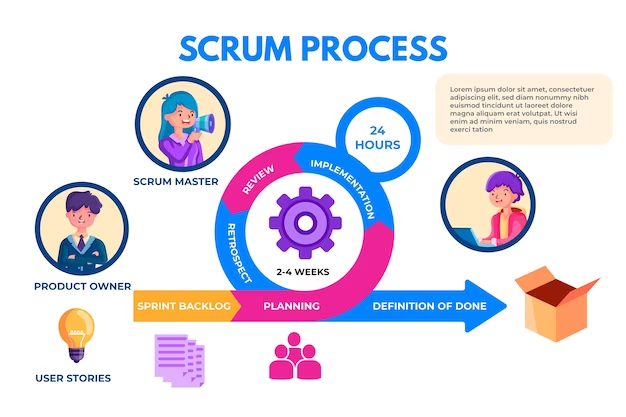
Scrum contains five events:
- Sprints – each sprint cycle lasts up to one month; teams complete an increment during each sprint;
- The initial planning meeting – deciding what to achieve in every sprint, establishing sprint or iteration goals;
- Brief daily sessions – during daily standups, employees update each other regarding their progress;
- Sprint review meetings – the purpose is to showcase your progress and increment to the project’s stakeholders;
- Sprint retrospective – discussing potential improvements; backlog refinements and release-planning discussions might follow.
Pros and Cons
Let’s look at some of Scrum’s pros and cons.
Scrum Advantages
Scrum has numerous benefits, including increased customer satisfaction.
Concrete Output
Every couple of weeks, my team completes a new set of deliverables. That’s one of the reasons I prefer Scrum since it allows us to remain focused and motivated and ship fully-functional outcomes.
As a team member, I feel valued and have a greater sense of accomplishment. Furthermore, I can easily visualize how the project will end because I can grasp the incremental benefits that appear after every sprint.
Better Customer Satisfaction
Customers are actively involved in Scrum projects. I think that’s highly effective, considering that teams know precisely what clients desire instead of just assuming it. Therefore, the final products will also be viable and created to meet the client’s requirements.
Higher Adaptability
I love how Scrum lets us offer and receive feedback after every sprint. That means we’re better prepared for the next project phase. Moreover, it also leads to boosted adaptability. So, I can say that Scrum lets you change or adjust your activities to overcome uncertainty and risks.
Other issues that may arise that require flexibility are sudden client demands and structure modifications inside the team.
Collaborative Execution
All those involved in Scrum projects are hands-on; they contribute with valuable inputs, suggestions, brainstorming ideas, and insights. In addition, many Agile methodologies, especially Scrum, encourage collaboration.
Hence, team members find it easier to solve issues, work together, and complete tasks. I’ve seen this particular benefit inside my team.
Continuous Improvement
Scrum teams can constantly improve the way they work and their abilities. This approach relies on daily briefings, retrospectives, and sprint reviews to ensure improvement.
Employees look back at their work, see their progress, and acknowledge their potential errors. This leads to improving themselves and delivering better results.
Scrum Downsides
From my professional experience, no methodology is perfect. So, Scrum also has a few disadvantages:
- There’s no definite end date – this could lead to unforeseen outcomes that one cannot predict when changes are made;
- Not suitable for larger teams – this agile framework is quite challenging for larger units; it works better for smaller teams because fewer employees can communicate easier and better;
- High failure risks – unless your employees are cooperative, serious, hard-working, and committed, the project might not go as planned;
- The need for experienced specialists – the result is successful and achieved as it should only if all team members are experienced;
- A higher level of frustration – I sometimes feel frustrated or annoyed by the daily meetings we must attend. I’m sure other colleagues feel the same way;
- Problems arise when a team member leaves the project – that could cause a significant negative impact that affects the entire team and the project;
- The lack of an in-depth testing process could cause quality-related issues.
Main Alternatives to Scrum

Here are some of Scrum’s alternatives.
Kanban
- Highly popular and easy to implement;
- Boosted work transparency;
- Explicit progress tracking;
- Feedback loops;
- Customizable;
- Not suitable for dynamic projects.
Lean
- Boosted focus and less waste;
- Lower costs;
- Resources are wisely used;
- Increased employee satisfaction;
- Low error margins;
- Potential frustrations among employees.
XP – Extreme Programming
- Continuous testing, which leads to stable programs;
- Great for software development;
- Pair programming leads to easier error avoidance;
- Higher costs and time-consuming.
FAQs
Answer: Several things make Scrum different from the general Agile approach. First, Scrum has shorter sprints, whereas Agile features continuous deliveries.
Second, Scrum has smaller deliverables, while Agile lacks any small deliverables. Third, Scrum employees are fewer and more experienced than Agile teams. Finally, Scrum teams are self-sufficient.
Answer: The best Scrum tools should offer transparency through multiple views. They should enable fast communication and have custom fields where employees can handle different tasks. Dashboards and reporting are also essential to visualize progress, updates, milestones, and more.
Answer: Some of the best Scrum tools I’ve worked with are Trello, Active Collab, Jira, Zoho Sprints, and Scrumwise.
Bottom Line
I love working with Scrum since it’s so flexible and easy to adjust. It allows me to come up with viable recommendations and be an active player on my team. Smaller project teams can truly benefit from this methodology. It’s highly innovative, so improvements are added to this framework regularly.
I can’t speak for you, but my next career goal is to become a Scrum Master. For that, I’ll have to complete a specialized course, but I’m not afraid of challenges.
Related read
- Complete Guide to PRINCE2 Project Management
- Complete Guide to RASCI
- Project Management Glossary of Terms: A Comprehensive List of PM Concepts
Sources
- Scrum in Project Management: The Complete Guide
- A Complete Guide to Scrum Project Management
- Considerations about the efficiency and sufficiency of the utilization of the Scrum methodology: A survey for analyzing results for development teams
- Scrum in Practice: an Overview of Scrum Adaptations
- SCRUM model for agile methodology
- The Scrum Framework Poster
- Scrum Framework
- What Is Agile Scrum Methodology?
- What is Scrum? The Scrum Framework explained!
- The Scrum Framework by International Scrum Institute

Alexandra is a passionate digital strategist who loves project management tools and principles. As a content writer, Alexandra has created many in-depth guides on e-commerce, digital marketing, and project management tools and is here to help the Projects Pivot readers learn more about managing projects and the digital tools that we use!
